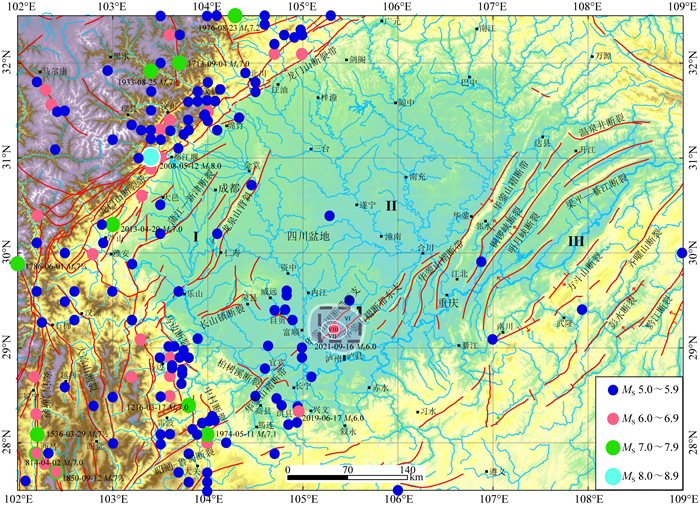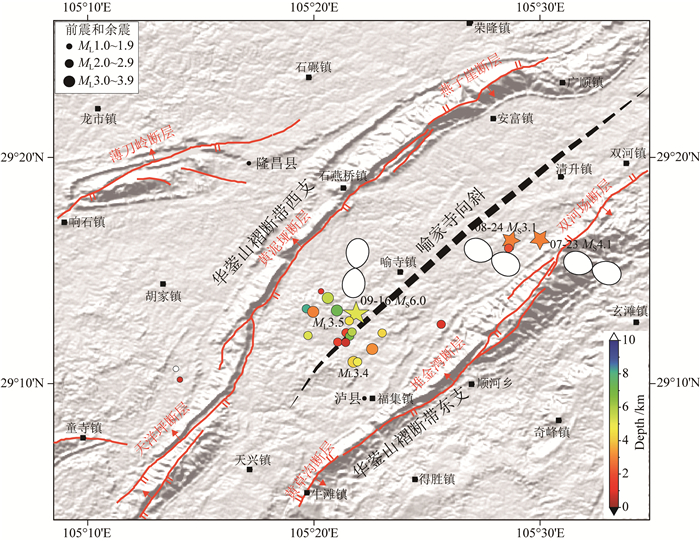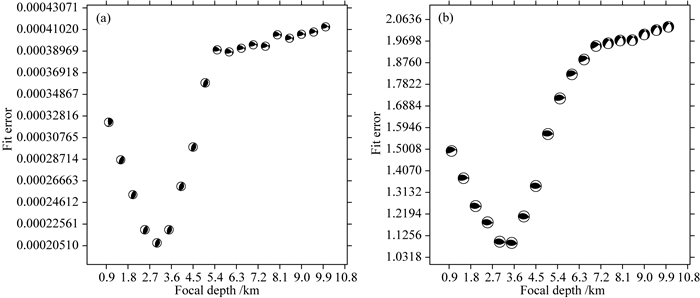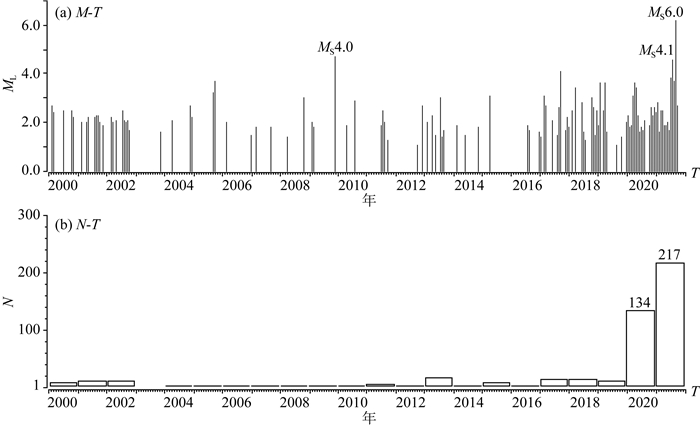Amelung F, King G. 1997. Large-scale tectonic deformation inferred from small earthquakes. Nature, 386(6626): 702-705. DOI:10.1038/386702a0 |
Deng B. 2013. Meso-Cenozoic Architecture of Basin-mountain system in the Sichuan Basin and its gas distribution[Ph. D. thesis] (in Chinese). Chengdu: Chengdu University of Technology.
|
Department of Earthquake Disaster Prevention, China Earthquake Administration. 1995. The Catalogue of Chinese Historical Strong Earthquakes (in Chinese). Beijing: Seismological Press.
|
Fang L H, Wu J P, Su J R, et al. 2018. Relocation ofmainshock and aftershock sequence of the MS7.0 Sichuan Jiuzhaigou earthquake. Chinese Science Bulletin (in Chinese), 63(7): 649-662. DOI:10.1360/N972017-01184 |
|
Gao Y, Shi Y T, Chen A G. 2018. Crustal seismic anisotropy and compressive stress in the eastern margin of the Tibetan Plateau and the influence of the MS8.0 Wenchuan earthquake. Chinese Science Bulletin (in Chinese), 63(19): 1934-1948. DOI:10.1360/N972018-00317 |
Gomberg J S, Shedlock K M, Roecker S W. 1990. The effect of S-wave arrival times on the accuracy of hypocenter estimation. Bulletin of the Seismological Society of America, 80(6A): 1605-1628. DOI:10.1785/BSSA08006A1605 |
Heidbach O, Rajabi M, Cui X F, et al. 2018. The World Stress Map database release 2016:Crustal stress pattern across scales. Tectonophysics, 744: 484-498. DOI:10.1016/j.tecto.2018.07.007 |
|
Klein F W. 2014. User's guide to HYPOINVERSE-2000, a Fortran program to solve for earthquake locations and magnitudes, Version 1.40. U.S. Geological Survey Open-File Report 02-171, doi: 10.13140/2.1.4859.3602.
|
Lü J, Wang X S, Su J R, et al. 2013. Hypocentral location and source mechanism of the MS7.0 Lushan earthquake sequence. Chinese Journal of Geophysics (in Chinese), 56(5): 1753-1763. DOI:10.6038/cjg20130533 |
Lei X L, Su J R, Wang Z W. 2020. Growing seismicity in the Sichuan Basin and its association with industrial activities. Science China Earth Sciences, 63(11): 1633-1660. DOI:10.1007/s11430-020-9646-x |
Lei X L, Wang Z W, Su J R. 2019. Possible link between long-term and short-term water injections and earthquakes in salt mine and shale gas site in Changning, south Sichuan Basin, China. Earth and Planetary Physics, 3(6): 510-525. DOI:10.26464/epp2019052 |
Li D H, Liao H, Ding Z F, et al. 2018. Joint inversion of the 3D P wave velocity structure of the Crust and Upper Mantle under the southeastern margin of the Tibetan Plateau using regional earthquake and teleseismic data. Acta Geologica Sinica, 92(1): 16-33. DOI:10.1111/1755-6724.13492 |
|
Long F, Yi G X, Wang S W, et al. 2019. Geometry and tectonic deformation of theseismogenic structure for the 8 August 2017 MS7.0 Jiuzhaigou earthquake sequence, northern Sichuan, China. Earth and Planetary Physics, 3(3): 253-267. DOI:10.26464/epp2019027 |
Long F, Zhang Z W, Qi Y P, et al. 2020. Three dimensional velocity structure and accurate earthquake location in Changning-Gongxian area of southeast Sichuan. Earth and Planetary Physics, 4(2): 136-177. DOI:10.26464/epp2020022 |
Long F, Qi Y P, Yi G X, et al. 2021. Relocation of the MS6.4 Yangbi earthquake sequence on May 21, 2021 in Yunnan Province and its seismogenic structure analysis. Chinese Journal of Geophysics (in Chinese), 64(8): 2631-2646. DOI:10.6038/cjg2021O0526 |
Luo Y, Zhao L, Zeng X F, et al. 2015. Focal mechanisms of theLushan earthquake sequence and spatial variation of the stress field. Science China Earth Sciences, 58(7): 1148-1158. DOI:10.1007/s11430-014-5017-y |
|
Rui X, Stamps D S. 2019. Strain accommodation in the Daliangshan Mountain area, southeastern margin of the Tibetan Plateau. Journal of Geophysical Research: Solid Earth, 124(9): 9816-9832. DOI:10.1029/2019JB017614 |
|
Tan Y, Zhu L P, Helmberger D V, et al. 2006. Locating and modeling regional earthquakes with two stations. Journal of Geophysical Research: Solid Earth, 111(B1): B01306. |
Tan Y Y, Hu J, Zhang H J, et al. 2020. Hydraulic fracturing induced seismicity in the Southern Sichuan Basin due to fluid diffusion inferred from seismic and injection data analysis. Geophysical Research Letters, 47(4): e2019GL084885. DOI:10.1029/2019GL084885 |
Vallage A, Devès M H, Klinger Y, et al. 2014. Localized slip and distributed deformation in oblique settings: the example of the Denali fault system, Alaska. Geophysical Journal International, 197(3): 1284-1298. DOI:10.1093/gji/ggu100 |
Wang M, Shen Z K. 2020. Present-day crustal deformation of continental china derived from GPS and its tectonic implications. Journal of Geophysical Research: Solid Earth, 125(2): e2019JB018774. DOI:10.1029/2019JB018774 |
Wang S Y. 1999. The Catalogue of Chinese Modern Earthquakes (in Chinese). Beijing: China Science and Technology Press.
|
|
Wong W C J, Zi J P, Yang H F, et al. 2021. Spatial-temporal evolution of injection induced earthquakes in Weiyuan area by machine-learning phase picker and waveform cross-correlation. Earth and Planetary Physics, 5(6): 1-15. DOI:10.26464/epp2021055 |
Wu Z L, Mu Q D. 1994. Modern earthquake catalogues. Recent Developments in World Seismology (in Chinese), (4): 1-4. |
Yang W, Chen G Y, Meng L Y, et al. 2021a. Determination of the local magnitudes of small earthquakes using a dense seismic array in the Changning-Zhaotong Shale Gas Field, Southern Sichuan Basin. Earth and Planetary Physics, 5(6): 1-15. DOI:10.26464/epp2021026 |
|
Ye Y H. 2018. Formation mechanism of shale reservoir inWufeng-Longmaxi formation in Sichuan Basin[Ph. D. thesis] (in Chinese). Chengdu: Chengdu University of Technology.
|
Yi G X, Long F, Vallage A, et al. 2016. Focal mechanism and tectonic deformation in the seismogenic area of the 2013 Lushan earthquake sequence, southwestern China. Chinese Journal of Geophysics (in Chinese), 59(10): 3711-3731. DOI:10.6038/cjg20161017 |
Yi G X, Long F, Liang M J, et al. 2019. Focal mechanism solutions andseismogenic structure of the 17 June 2019 MS6.0 Sichuan Changning earthquake sequence. Chinese Journal of Geophysics (in Chinese), 62(9): 3432-3447. DOI:10.6038/cjg2019N0297 |
Yi G X, Long F, Liang M J, et al. 2020. Geometry and tectonic deformation ofseismogenic structures in the Rongxian-Weiyuan-Zizhong region, Sichuan Basin: insights from focal mechanism solutions. Chinese Journal of Geophysics (in Chinese), 63(9): 3275-3291. DOI:10.6038/cjg2020O0095 |
Zhang J, Kuang W H, Zhang X, et al. 2021. Global review of induced earthquakes in oil and gas production fields. Reviews of Geophysics and Planetary Physics, 52(3): 239-265. DOI:10.19975/j.dqyxx.2020-027 |
|
Zhao B, Gao Y, Liu J, et al. 2019. Focal mechanism inversion and source depth locating of moderate-major earthquakes in the Sichuan region since 2010. Chinese Journal of Geophysics (in Chinese), 62(1): 130-142. DOI:10.6038/cjg2019M0155 |
Zhao B, Gao Y, Liu J, et al. 2020. Interferometric source imaging of Sichuan Changning MS6.0 earthquake. Seismology and Geology (in Chinese), 42(6): 1474-1491. DOI:10.3969/j.issn.0253-4967.2020.06.013 |
|
Zhao M, Long F, Yi G X, et al. 2021. Focal mechanism andseismogenic structure of the MS5.1 Qingbaijiang earthquake on February 3, 2020, southwestern China. Frontiers in Earth Science, 9: 644142. DOI:10.3389/feart.2021.644142 |
Zheng Y, Ma H S, Lü J, et al. 2009. Source mechanism of strong aftershocks ( MS ≥ 5.6) of the 2008/05/12 Wenchuan earthquake and the implication for seismotectonics. Science in China Series D: Earth Sciences, 52(6): 739-753. DOI:10.1007/s11430-009-0074-3 |
|
Zhu L P, Helmberger D V. 1996. Advancement in source estimation techniques using broadband regional seismograms. Bulletin of the Seismological Society of America, 86(5): 1634-1641. DOI:10.1785/BSSA0860051634 |
邓宾. 2013. 四川盆地中-新生代盆-山结构与油气分布[博士论文]. 成都: 成都理工大学.
|
高原, 周蕙兰, 郑斯华, 等. 1997. 测定震源深度的意义的初步讨论. 中国地震, 13(4): 13-21. |
|
国家地震局震害防御司. 1995. 中国历史强震目录. 北京: 地震出版社.
|
|
雷兴林, 苏金蓉, 王志伟. 2020. 四川盆地南部持续增长的地震活动及其与工业注水活动的关联. 中国科学: 地球科学, 50(11): 1505-1532. |
|
|
|
|
|
汪素云. 1999. 中国近代地震目录. 北京: 中国科学技术出版社.
|
吴忠良, 牟其铎. 1994. 现代地震目录. 国际地震动态, (4): 1-4. |
叶玥豪. 2018. 四川盆地五峰-龙马溪组页岩储层形成机理[博士论文]. 成都: 成都理工大学.
|
|
|
|
|
|
|
|
郑勇, 马宏生, 吕坚, 等. 2009. 汶川地震强余震(MS ≥ 5.6)的震源机制解及其与发震构造的关系. 中国科学D辑: 地球科学, 39(4): 413-426. |
周荣军, 唐荣昌, 钱洪, 等. 1997. 地震构造类比法的应用——以川东地区华蓥山断裂带为例. 地震研究, 20(3): 316-322. |
 2021, Vol. 64
2021, Vol. 64










